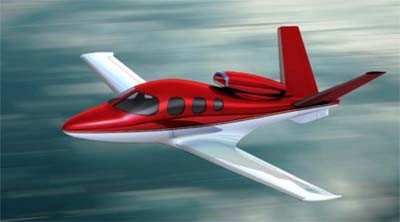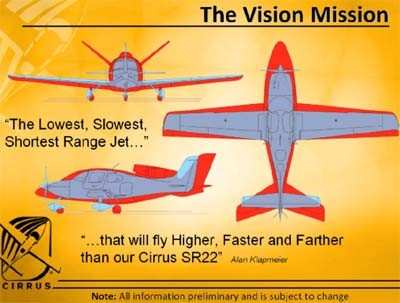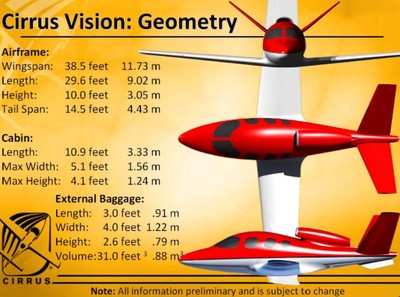6000 Lbs. Max Takeoff Weight; 400 Lb Payload With Full
Fuel
During a web conference Wednesday morning, the team at Cirrus
Design updated the media, its customers and competitors about the
status of its Cirrus SJ50 Vision program... and finally provided
some hard performance numbers for the aircraft.

Cautioning that all information is still subject to change,
Cirrus currently forecasts a maximum takeoff weight of 6,000 lbs,
with a maximum ramp weight 60 lbs higher. Cirrus states its current
estimates target a 2300 lb. usable load, with 400 lbs available for
passengers and baggage with full fuel.
"Customers told us 'give me more fuel,' said Cirrus CEO Alan
Klapmeier, adding Cirrus increased its full fuel and max fuel
weights by 100 pounds over its earlier estimates.

As for target performance numbers, Cirrus is in no danger of
breaking Klapmeier's promise to build the "lowest, slowest,
shortest range" jet on the market... though the Vision is still
making some impressive numbers in testing.
The VI prototype aircraft now flying as seen a maximum speed of
319 KTAS; Cirrus targets a 300 KTAS high speed cruise speed, with
the best range of over 1,400 nm available at a more
SR22-like 210 KTAS.
Speaking of the SR22, Klapmeier pointed out the piston-powered
SR22 G3 Turbo burns 17 gallons of avgas per hour at 210 kts with
two people onboard. "At slightly less than twice the fuel
consumption, the Vision will carry twice as much," he said --
excellent performance for a turbine-powered aircraft.

To date, Cirrus has flown the non-conforming prototype for
approximately 120 hours, with a full range of tests performed --
including maximum and minimum controllable airspeeds and a full
stall series, flown throughout the CG range. Cirrus has also
performed inflight restart tests of the aircraft's Williams
FJ33-4A-19 powerplant.
Testing has revealed some changes to be made to the final spec
aircraft. The production Vision will sport a slightly taller V-tail
empennage, with less sweep incorporated into the leading edge. Mike
Van Staagen, head of SJ50 development at Cirrus, said the change
will save about 45 lbs in the tail section.
The current plane's single ventral fin may also be modified,
with a larger fin ready to be fitted to the V1 aircraft. The
company hopes to incorporate a yaw damper system tied to the
ventral fin, rather than going through the expense and complexity
of fitting such a system to the V-tail assembly.

"With the Vision, everything starts out simple... we add
complexity if needed," Van Staagen quipped.
The V1 aircraft is also flying with an engine nozzle canted 12
degrees upward, providing 4 degrees of up-angle thrust. The
aircraft initially flew with a nozzle pitched 6.5 inches up; Cirrus
made the change to measure its effectiveness in reducing pitch
coupling with changes in power -- the bane of all single-engine
jets with engines mounted atop the fuselage.
While no significant changes have been made to the aircraft's
long-chord wing, Cirrus has removed the original concept's
winglets, saying the added weight offset any performance advantages
the winglets provided. V1 flies with wing cuffs quite similar to
those seen on the SR22.

While Cirrus has yet to officially decide on which method of
deicing the Vision will use -- boots, or TKS -- V1 is now flying
with a pair of silicone appliques designed to represent the "worst
case" deployment of pneumatic deicing boots, and the company seems
impressed with their performance.
Cirrus also notes those boots save about 40 lbs. of weight over
TKS with a full load of deicing fluid... a strong
consideration.

Other noticeable changes between V1 and the production aircraft
include the removal of the right-side passenger door... a change
Klapmeier resisted, but was made in the name of reducing complexity
and to decrease fault conditions. An emergency egress
hatch will take its place.
The production plane will also sport a slightly wider nose
section, to better accommodate the retractable nosegear. The nose
will incorporate a smoother transition to the windshield, leading
to a fuselage with a more circular cross-section. Cirrus has also
made improvements to the fuselage transitions to the wing leading
edge and root fairings.
Klapmeier remained elusive about the company's targets for entry
into service, and price. "Best case? January 2009," he quipped...
before adding a timeframe for first deliveries occurring sometime
in 2011 -- or even 2012 -- is more realistic.

As for price, Klapmeier said a "further refinement" to the
Vision's base price is forthcoming, though he declined to give
exact numbers. Earlier estimates pegged the price of a
well-equipped SJ50 at around $1.25 million.
While stressing the SJ50 will not be a business aircraft, but a
personal jet -- "However you might use your automobile, is how
you'll use this airplane" -- Klapmeier did weigh in on the recent
furor surrounding executives' use of business jets for travel.
"Corporate jets are productivity tools, not perks," he said,
lamenting that General Motors and Ford recently announced they
would slash their own corporate jet fleets.
 Aero-TV: DeltaHawks Diesel Power Steps Into the Spotlight
Aero-TV: DeltaHawks Diesel Power Steps Into the Spotlight NTSB Prelim: Mooney Aircraft Corp. M20K
NTSB Prelim: Mooney Aircraft Corp. M20K ANN FAQ: Turn On Post Notifications
ANN FAQ: Turn On Post Notifications ANN's Daily Aero-Linx (12.20.25)
ANN's Daily Aero-Linx (12.20.25) Aero-News: Quote of the Day (12.20.25)
Aero-News: Quote of the Day (12.20.25)









